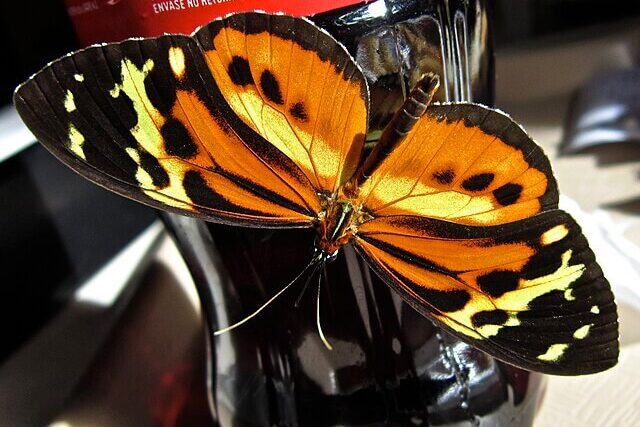
The world is becoming less colourful. For butterflies, vivid and striking wings once meant survival – helping them to attract mates and avoid predators. Yet new research suggests that as humans replace vibrant tropical forests with uniform landscapes, the natural world is losing its colour.
“The colours on a butterfly’s wings are not trivial – they have been designed over millions of years,” says researcher and photographer Roberto García-Roa, who is part of a project in Brazil documenting how habitat loss is bleaching the natural world of colour.
In tropical forests, where shades range from deep green to dazzling red, butterflies thrive in diverse habitats that allow them to communicate, camouflage, and reproduce. But as humans replace these forests with monocultures such as eucalyptus plantations, the environment becomes far less varied. In these simplified settings, duller species fare better – blending in with their muted surroundings becomes an advantage.
The difference is stark, researchers say. “You feel alive in the tropical forest, everything is wild – you never know what you are going to find,” says García-Roa. “When you arrive at a eucalyptus plantation it’s very frustrating – you can feel that things are not happening as they should be in a natural ecosystem. Animals are not around, and sounds are not as they should be.”
These early findings form part of a growing field of research into “discoloration”,, which explores how the loss of natural habitats is changing the world’s colours.
Butterflies are an ideal focus for this work: they are among the most colourful organisms on Earth, they inhabit a wide range of environments, respond quickly to change, and are relatively easy to monitor.
Colour, however, is about more than beauty – it plays crucial evolutionary roles. In a broader trend across ecosystems, once-vibrant environments are becoming increasingly muted as they are degraded, simplified, and polluted by human activity. Coral reefs are bleaching, oceans are turning greener, and even rainbows are predicted to become less visible in heavily populated and polluted regions.
Nature’s palette has always shifted in response to natural selection. A classic mid-20th-century example is the peppered moth, which turned black during the Industrial Revolution to blend in with soot-covered trees. But scientists warn that with human activity there are likely to be more rapid and widespread changes ahead .
“Even planet Earth itself is losing brightness as seen from space. It is truly remarkable and concerning how interconnected these processes are, and how every impact cascades into further consequences,” says Ricardo Spaniol from the Federal University of Rio Grande do Sul.
In the Brazilian state of Espírito Santo, north of Rio de Janeiro, researchers recorded 21 butterfly species in eucalyptus plantations and 31 in natural forests – with many more still to be identified.
“One thing that is obvious is that in eucalyptus plantations, butterfly communities are dominated by brown-coloured species,” says lead researcher, Maider Iglesias-Carrasco from the University of Copenhagen. There was a “general feeling of emptiness” in the plantations, she added.
The idea that colourfulness could become a disadvantage in the Amazon first emerged in 2019. Ricardo Spaniol and his team found that butterfly species changed significantly depending on their environment – and their colours changed accordingly.
“The most colourful species are often the first to disappear locally after deforestation, probably because of the loss of native vegetation and their increased exposure to predators. This represents an accelerated process of discoloration in Amazonian butterfly communities,” says Spaniol.
In deforested areas, butterflies tended to have brown or grey wings and bodies, while in intact forests, both vibrant and muted species were found together. The consistency of this pattern surprised researchers and opened up a new field of inquiry into how habitat loss affects biodiversity.
“Discovering that forests are losing their colours was frightening and revelatory,” says Spaniol. “It felt like we were uncovering a hidden dimension of how species respond to environmental change, a dimension that had remained invisible until then, but is incredibly rich.”
A decline in colour diversity may signal the breakdown of ecological functions, explains Spaniol, from the Federal University of Rio Grande do Sul.
Butterflies are often considered indicators of broader biodiversity trends, says Spaniol: “A decline in their colour diversity may reflect a loss of complexity in ecosystems as a whole, with potential cascading effects on other organisms and ecological processes.”
From the Amazon to California and Spain, vast areas are being covered by monoculture plantations. Eucalyptus forests alone – widely grown for timber, pulp, and paper – now cover at least 22m hectares (54 million acres) globally. Scientists are still unsure whether their effects are the same across regions.
Researchers don’t know whether the impact of plantations is homogeneous across the planet. “Coffee and banana plantations are always green, and people associate green with nature, but they are not [natural],” says García-Roa.
If native habitats continue to disappear, many of the most colourful and ecologically specialised butterfly species could vanish, leaving only a handful of generalist species behind.
“This would mean not only a loss of beauty, but also the disruption of important ecological interactions that depend on colour signals,” says Spaniol.
However, this outcome is not inevitable. Spaniol’s research found that parts of the Amazon rainforest that have regenerated for 30 years after being cleared for cattle pasture have shown a striking recovery in butterfly colour diversity – offering hope that, with time and protection, nature’s colours can return.
“We still have the opportunity to restore this colourful world,” he says.
——————————————————————————
At Natural World Fund, we are passionate about restoring habitats in the UK to halt the decline in our wildlife.

